| SJ23 Tech Tip C18, (Updated 2021-09-29) Bob Schimmel | |
|
Galley Rigid Water Tank & Pump for Panache,
(1987). |
|
|
Shortly after I bought Panache I moved the fresh water tank from under the cockpit to the empty void under the forward berth because I needed the storage space under the cockpit for light bulky stuff. It seemed like the most logical place to put the tank. Later I discovered that the extra weight in the bow helps to offset the crew weight in the cockpit which makes for faster sailing, more responsive handling, higher pointing and less hunting at anchor. An SJ23 sails at its optimum while on its water line. Leave it to me to find a couple of technical reason for a nice practical solution! See Note 1. The rigid 10 gallon (45.5 L) rectangular tank is made of white polyethylene. It is translucent so in daylight it is fairly easy to see how full the tank is. While it just fits through the access hole in the forward berth, it was a hassle to pull out for end of season service as I always scraped my knuckles. Problem is, it is difficult to support the tank properly over the V shape of the hull and also keep it in place while heeled at 250 in pounding waves. A full 10 gallon tank (45.5 L) weighs about 100 pounds (45.4 Kg) and it generally slid to an odd angle, jamming between the hull and the bottom of the berth. I doubt this was any good for the tank, the fittings, hoses, let alone the hull! The bow location has operational advantages, so I made a proper support shelf to support the tank and sloped it aft so water could drain drip dry for winter storage. This has worked so well that the tank has never been removed since it was installed here in 1987. Fig 1 shows the tank installed. What is not shown are the long wedges of dense neoprene foam that I jamb between the top of the tank and the bottom of the berth to securely hold the assembly down, vibration free. CONSTRUCTION - To support the tank over the V shaped hull I fashioned a plywood shelf with two form fitted feet glued to the hull with Sikaflex. The shelf has never moved.
ABOUT POLYETHYLENE TANKS & FITTINGS: Most polyethylene tanks come without hose fittings unless it is a purpose made tank. So if you purchase one, fit it in the boat and determine where you want the fittings to be. Mark the spot with a felt pen and take the tank to the dealer or RV repair shop where they can "weld" the fitting to the tank. If you have a leaky fitting or want another one installed, they can do that as well. These shops have a tool that resembles an electric drill that holds the fitting while it is spun against the body of the tank. The friction created between the fitting flange and the tank melts the polyethylene on both sides. When the two surfaces become soft enough, the operator simply stops the spinning the fitting and holds the tool steady against the tank till the conglomerate mess cools and solidifies. The operator knows from experience when to stop turning. Leak fixed! One sure way to screw up a fused fitting like this is to apply side strain on it from a hose. So support the hose to eliminate all strain on the fitting.
SELECTING a WATER PUMP for the SINK: It is most desirable to have a dependable pump so you can draw drinking water from the tank at any time. After all, drinking water is sort of important to sustain life on this planet. The irony is that you may be floating on the stuff but can't drink it! Having said that, the pump should also operate quietly so you don't disturb the sleeping crew. This is why many people choose a manual pump. It's usually very dependable and operates without electrical power. The down side is that you have to operate it by hand or foot depending on the style. This is OK as you will use less water. I prefer a foot operated pump as they free your hands to hold a glass under the tap. For an electric pump I prefer a demand pump because they are quieter and consume less power than a pressure regulated demand wobble pump you find on a holiday trailer. Some boats have two pumps, a manual foot pump for sea water and an electric pump for drinking water. This saves the drinking water when all you need to do is rinse. Salt water is a natural antiseptic. A foot pump installed through the settee wall close to the sink is relatively easy to install since it requires such a small hole. Make the corners of the hole slightly rounded to prevent cracks from developing. If done right, the pump's mounting plate should restore the strength of the settee wall hole. Just make sure you install it where you are unlikely to trip on it. Also make sure you can access the pump reasonably well for maintenance. By the way, you can judge the complexity of a boat by the number of pumps on board! WATER QUALITY - Always pour clean tap water into the tank. Then add a cap of Clorox (chlorine) or bleach to a full tank (10 gallons) of water to inhibit bacteria growth. The vent line is equipped with a screen to keep bugs out. The end of season tank drain ensures no sediment in the tank. For these reasons I have not seen it necessary to filter the water to the galley faucet. But if you find it necessary to treat your drinking water it is recommended to go through the following three-step treatment;
DECONTAMINATE A TAINTED TANK - There is a standard sanitizing procedure for recreational vehicles (ANSI A119.2 section 10.8) that works just as well for boats. Iíve added a few details, but the bones of it comes straight from the code and have been reviewed and accepted by the U.S. Public Health Service. WINTER STORAGE - Since there are no sags to trap water in the fill or vent lines I pump the tank dry just before haul out up the ramp. The tank will be almost empty when I pull Panache up the ramp. Then at her winter parking spot I remove the drain hose and collect the last bit of water out of the tank. Lastly I blow out the remaining water through the pump, into the sink and out the hull, ready for winter freeze up. Then to protect the pump I shake the water droplets out of it and give it a quick spray of cooking oil to prevent internal corrosion. Sure a lot simpler than my previous method of removing the tank every Fall to drain it. SAILING PERFORMANCE - What came as a total surprise was the improved sailing performance with the bow weighed down, sailing the boat on its lines. Later I realized the combination of the rigid shelf (acting as a grid) glued to the hull, also added stiffness to the bow. With the added weight of the water plus the foam jammed between the top of the tank and the V-berth, it really helps to deaden the sound of punching through bigger waves. NOTE 1 - While much has been said about adding weight to the bow to level the boat for fast sail performance, an easy weight would be to tie a five gallon jug of water in the front of the V-berth. This will add about forty pounds to the bow and you can vary the amount of water as you need. There never seems to be enough drinking water when you are cruising anyway. Five gallons should last about four days if restricted to drinking. Fifty gallons of water should last about 5 to 7 days if the electric pump is switched off and the hand pump is used. NOTE 2
-
A vent line is required to let air out of the tank while filling with water or into the tank while draining. This permits the fastest flow by preventing air bubbles coming up the fill line, blocking water. It could also handle an overflow but this action should be discouraged to minimize the extra column pressure on the tank and fittings. The column pressure increases a disproportionate amount for the slight extra volume stored in the filler tube. This is also a strain on seals that are NOT designed for it. The last thing you want is a bilge full of drinking water just because you wanted a measly extra cup of water. |
|
|
Return to Tech Tip Index. . . . . . . . . . . . . . . Have a Question? |
|
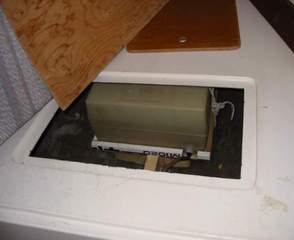
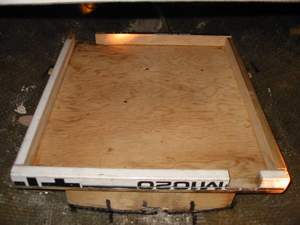
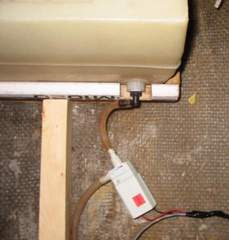
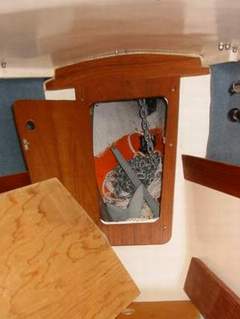
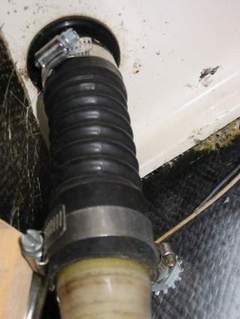
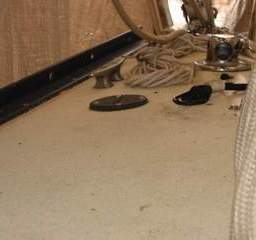
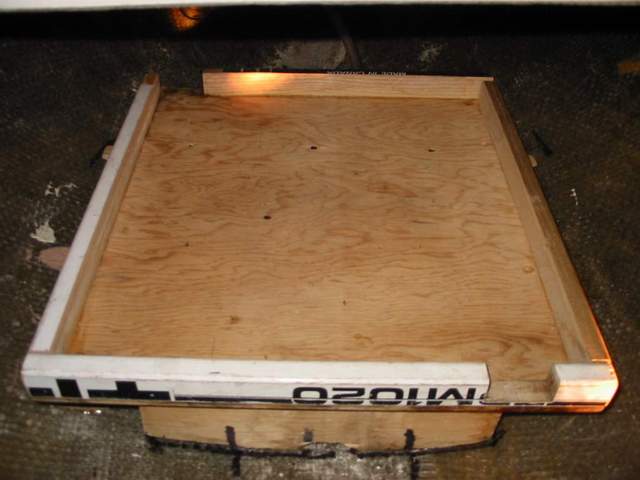 A 1/2" vinyl vent line parallels the fill line and is connected to an OMC
gas tank vent installed through the hull at the upper side of the
anchor locker.
A 1/2" vinyl vent line parallels the fill line and is connected to an OMC
gas tank vent installed through the hull at the upper side of the
anchor locker.